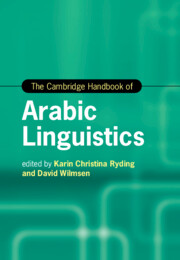Book contents
- The Cambridge Handbook of Arabic Linguistics
- Cambridge Handbooks in Language and Linguistics
- The Cambridge Handbook of Arabic Linguistics
- Copyright page
- Contents
- Figures
- Tables
- Notes on Contributors
- Acknowledgements
- Abbreviations
- Introduction
- Part I Arabic Applied Linguistics
- Part II Arabic Variation and Sociolinguistics
- Part III Theoretical and Descriptive Studies
- 12 Grammaticalization in Arabic
- 13 Arabic and Onomastics
- 14 The Intonation of Arabic
- 15 Case in Arabic
- 16 On Arabic Morphosyntax and Its Implications for the Theory of Generative Grammar
- 17 Arabic Morphology
- Part IV Arabic Computational and Corpus Linguistics
- Part V Arabic Linguistics and New Media Studies
- Part VI Arabic Linguistics in Literature and Translation
- Index
- References
13 - Arabic and Onomastics
from Part III - Theoretical and Descriptive Studies
Published online by Cambridge University Press: 23 September 2021
- The Cambridge Handbook of Arabic Linguistics
- Cambridge Handbooks in Language and Linguistics
- The Cambridge Handbook of Arabic Linguistics
- Copyright page
- Contents
- Figures
- Tables
- Notes on Contributors
- Acknowledgements
- Abbreviations
- Introduction
- Part I Arabic Applied Linguistics
- Part II Arabic Variation and Sociolinguistics
- Part III Theoretical and Descriptive Studies
- 12 Grammaticalization in Arabic
- 13 Arabic and Onomastics
- 14 The Intonation of Arabic
- 15 Case in Arabic
- 16 On Arabic Morphosyntax and Its Implications for the Theory of Generative Grammar
- 17 Arabic Morphology
- Part IV Arabic Computational and Corpus Linguistics
- Part V Arabic Linguistics and New Media Studies
- Part VI Arabic Linguistics in Literature and Translation
- Index
- References
Summary
Terrence Potter contributes an overview of Arabic onomastics starting with the origin of Old Arabic or Proto-Arabic names known from epigraphic studies of pre-Islamic Semitic names, and from Nabatean inscriptions. He then proceeds to the analysis of Classical Arabic names and the importance of name structure to the discipline of Islamic genealogy. Citing the work of Ibn Kalbī, Ibn Durayd, and Ibn Ḥazm, Potter stresses ‘the importance of names in Arabo-Islamic society’ and discusses the interest of Western and Arab scholars in biographical texts in order to codify and organize knowledge of the historical content and context of Arab culture. He then examines the syntax and the lexical components of both male and female names and surveys traditional naming practices up to contemporary times.
- Type
- Chapter
- Information
- The Cambridge Handbook of Arabic Linguistics , pp. 309 - 329Publisher: Cambridge University PressPrint publication year: 2021



